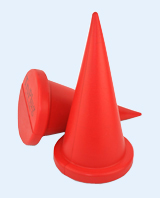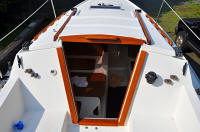|
|

Chip Ford's 1974 Catalina 22
Restoration Project
Sail #3282 l Marblehead, Massachusetts |
|
The never-ending project to fill my hole in
the ocean while bailing it out
Preparing for Sailing Season 2011
Spring Pre-Launch Preparations
|
| Click
thumbnails for a larger picture |
 |
When I tried closing the Marelon
ball valve while disconnecting the scupper drain hoses I discovered its
handle wouldn't budge. After removal I found it beyond repair. I ordered
a new ball valve from West Marine. It took a few days for them to get
one, but in the meantime I received some advice from Peter Kroos,
another C22 sailor from Daytona, Florida: The ball valve handle needs to
be opened and closed often just for maintenance, and greased frequently.
Forespar Spec Sheet |
Recommended Maintenance When
I picked up the ball valve this morning it had a removable maintenance
tag on it, something I don't recall getting with the initial valve back
in 2003. Maybe other customers have had the same problem
– being unaware it needed to be carefully
maintained. I installed it this
morning, connected the fittings and hoses, the the cockpit now drains
perfectly. I'm still puzzled why it didn't before, as the valve was
frozen in its open position and I found no serious blockage anywhere
along the lines. I cleaned everything: the scupper screens, the insides
of both hoses and brass T fittings, through the threaded bronze fitting
fiberglassed through the hull. Other than the expected and minimal
grime, I found nothing that would obstruct the flow. (May 27,
2011) |
 |
 |
 |
 |
 |
|
|
While considering the ball valve's purpose, I decided
what's really needed is a way to plug the hole in the bottom of the hull
if something goes wrong with it. When I came upon the
Forespar
Truplug I thought it is the perfect solution, ordered one for $19.95.
It'll be added to the
safety equipment aboard. |
 |
|
 |
While awaiting delivery of the ball valve I went to work
on touching up the teak trim. Since
refinishing it 2008 the
pieces are showing some wear in spots. I'm hoping to get a another year
or two out of that project with a little maintenance, before the exposed
teak beneath the dinged and scratched Cetol begins to weather more. It won't be perfect, but
a
touch-up will protect and extend the job's life. (May 26, 2011) |
 |
 |

|
 |
 |
 |
Yesterday I mixed a small amount of Cetol with Penetrol
as usual in a baby food jar. For the handrails and sliding hatch runners
I used one of my squirrel-hair lettering brushes from my sign-painting
days, perfect for tight detailed work. After masking off around the
companionway trim, I used a 1 inch brush. The finish covered and will protect the teak for another season, but
everything needs to be sanded and fully refinished if perfection is to
again be achieved. (May 27, 2011) |
 |
 |
 |
 |
 |
 |
This morning I launched into the
tedious job of cleaning out the cabin. I cut corners
last spring, ran out of
ambition especially in the
v-berth area and the overhead, but that bothered me all last season.
I was determined to improve on that this season.
I used a strong mixture of about one
part Pine-Sol to two parts water in a bucket and, instead of the usual
large sponge, used a small kitchen sponge with a Scotchbrite backing.
The Scotchbrite was an amazing improvement especially where the mildew
and mold were heaviest. For the first time ever, I was even able to
remove the grunge and corrosion that I thought was permanent from the
pop-top struts, make them shiny.
Scrubbing in the cramped v-berth, and
especially the entire overhead, was wearing but starting the season with
a thoroughly clean cabin this year was good motivation. I finished
cleaning all the areas above the cabin shelves. I'll continue the
scrubbing tomorrow morning (after helping Vaughn McGrath raise his mast
on "French Curves") then rub on a coat of wax where possible, to
hopefully cut down on future mildew buildup. (May 27, 2011) |
 |
 |
 |
 |
 |
 |
While helping Vaughn McGrath
raise the mast on his
C22, "French Curves," this morning he pointed out the new
deck cleats
he'd recently installed amidship for tying off a spring line. Bingo,
this is something I've vowed to do for years along my cruises when tying
up to a slip or dock. I've always used a lifeline stanchion as a
makeshift cleat, which isn't good on the stanchion and its base; sooner
or later it's going to create a leak in the deck. Unfortunately, I've
never thought about it until it's infrequently needed, almost
exclusively along my cruises.
On the way home from Marblehead Harbor
I stopped at West Marine and bought a pair of medium duty nylon cleats
and the necessary hardware. It took about an hour this afternoon to
drill, mount and bed them. Tomorrow I'll tighten the four Nyloc nuts and
¼ x 2½" screws into the 3M 4200 sealant. For about $20 and an hour's work Chip Ahoy now
has spring line deck cleats. I'm sure the stanchions will appreciate this
minor addition. (May 28, 2011) |
 |
 |
 |
|
NEXT |
|
Getting Ready for Sailing Season 2011! |
|

|